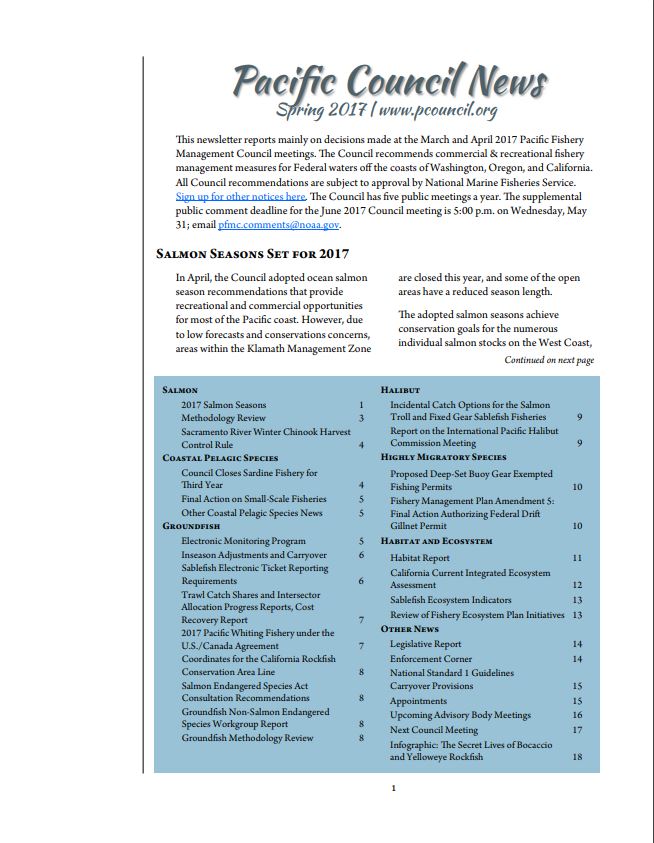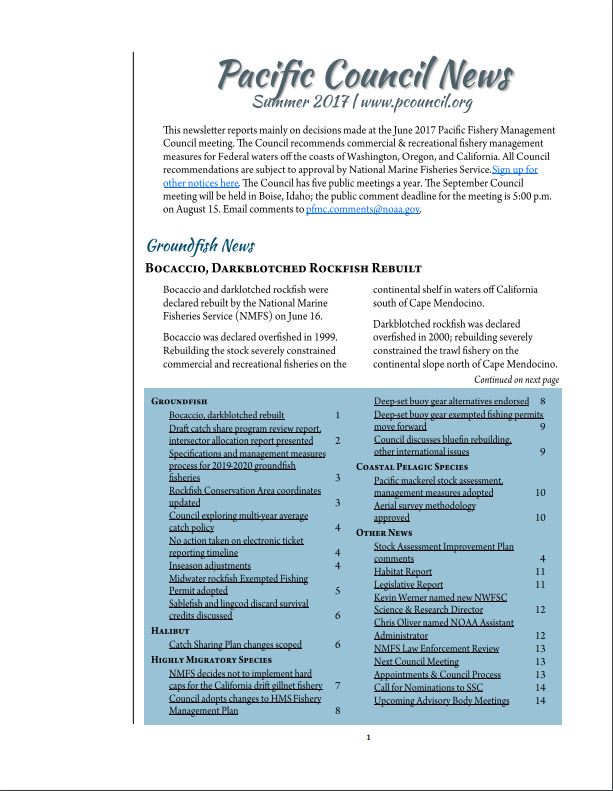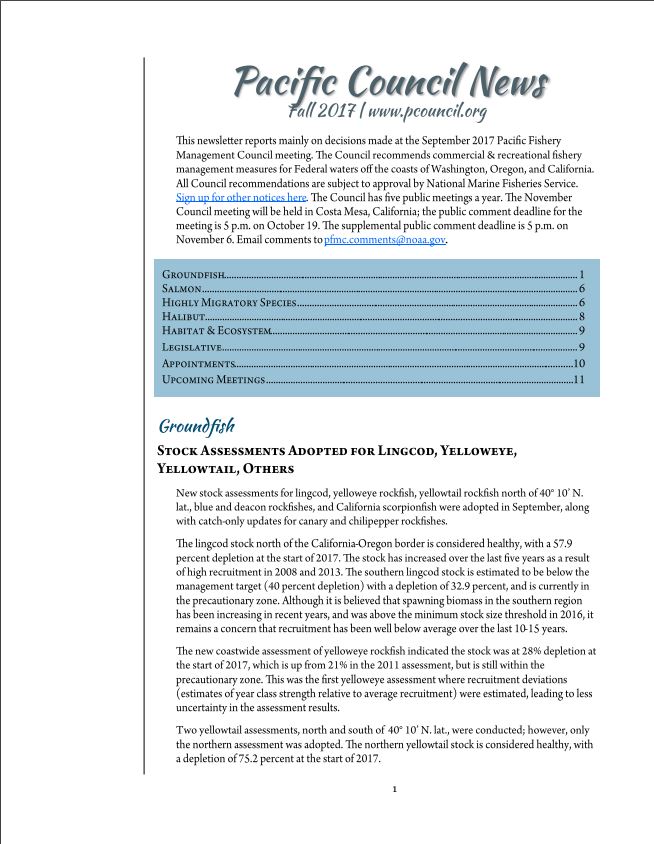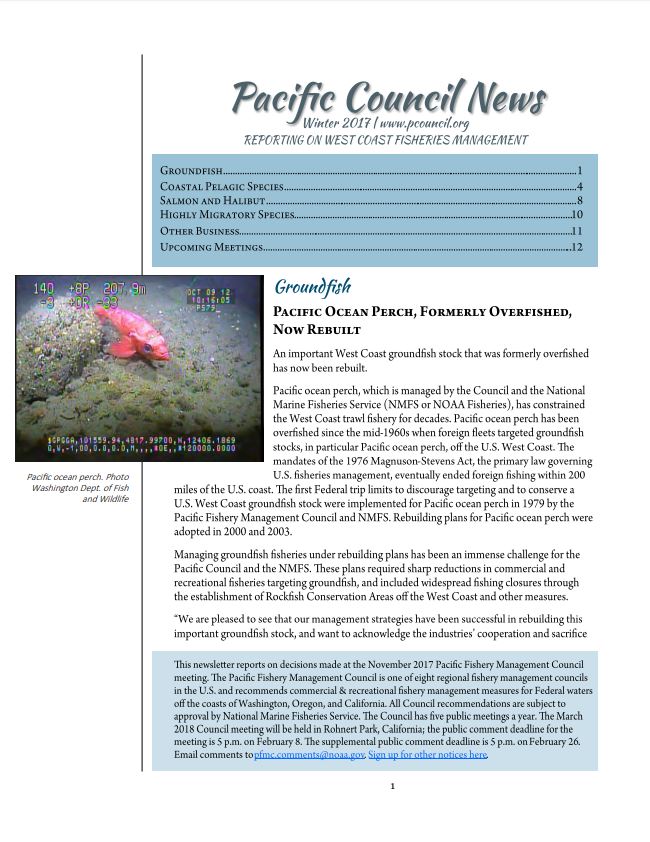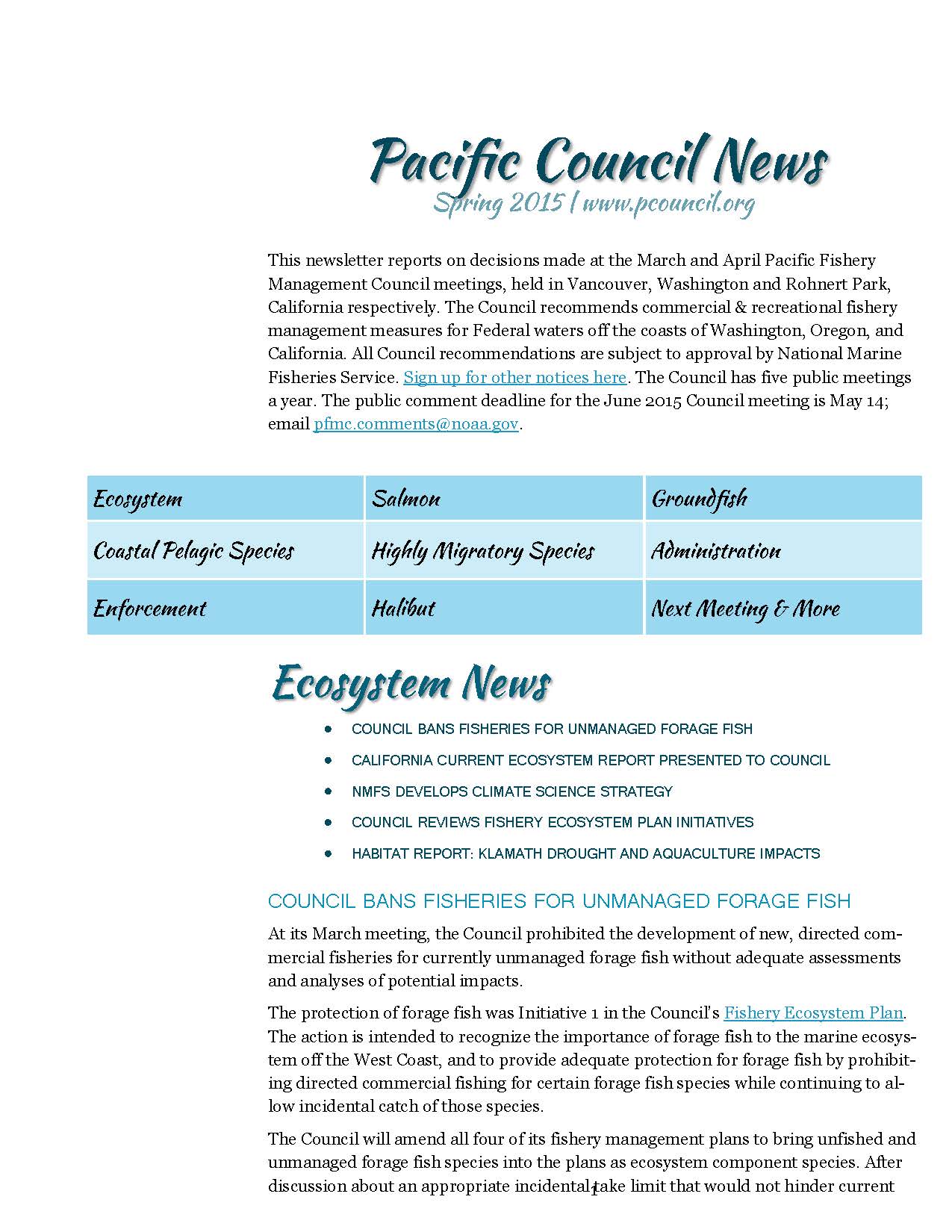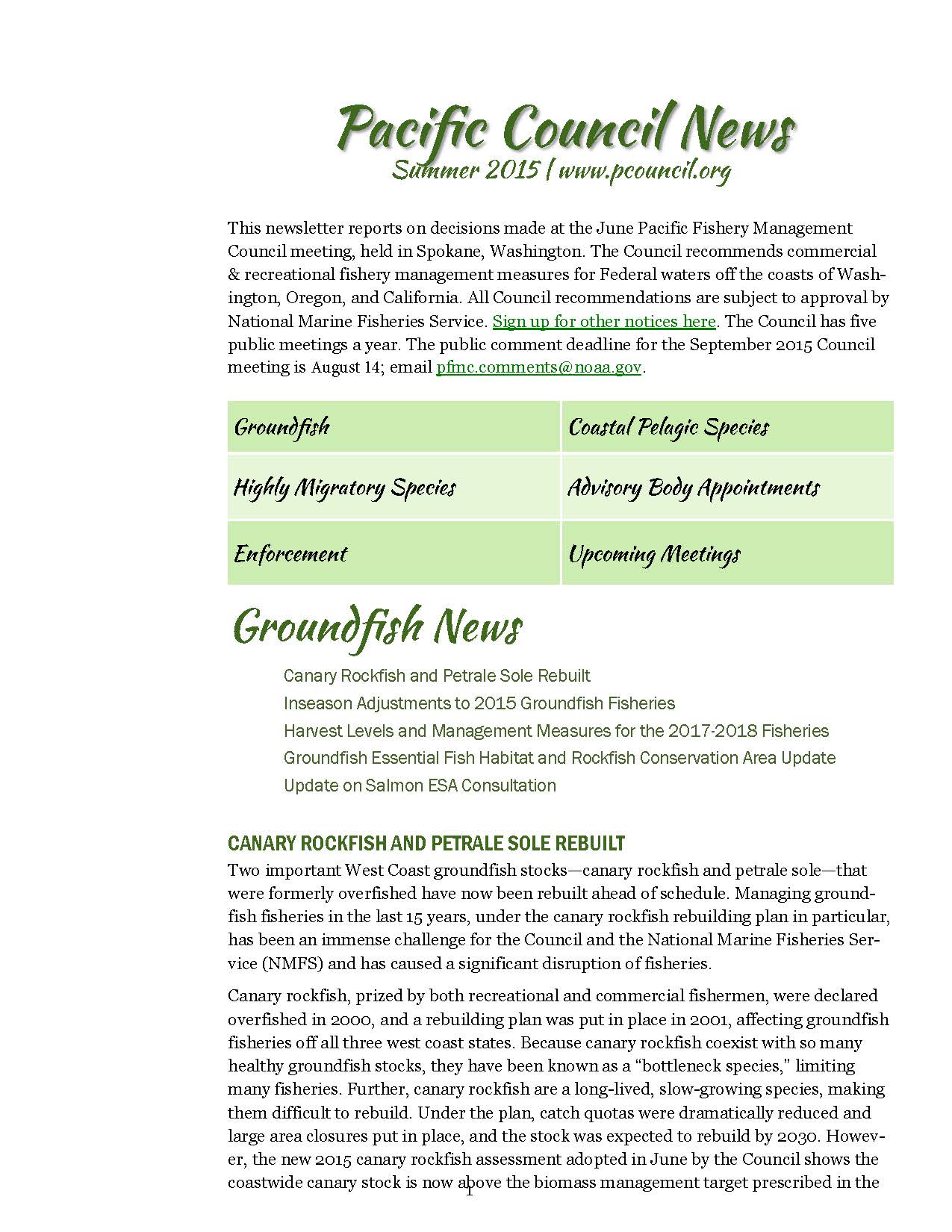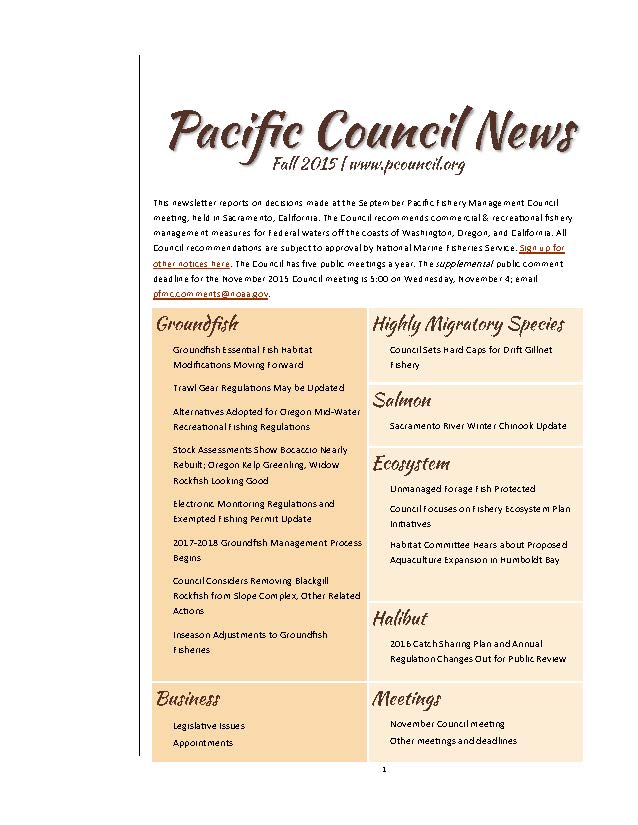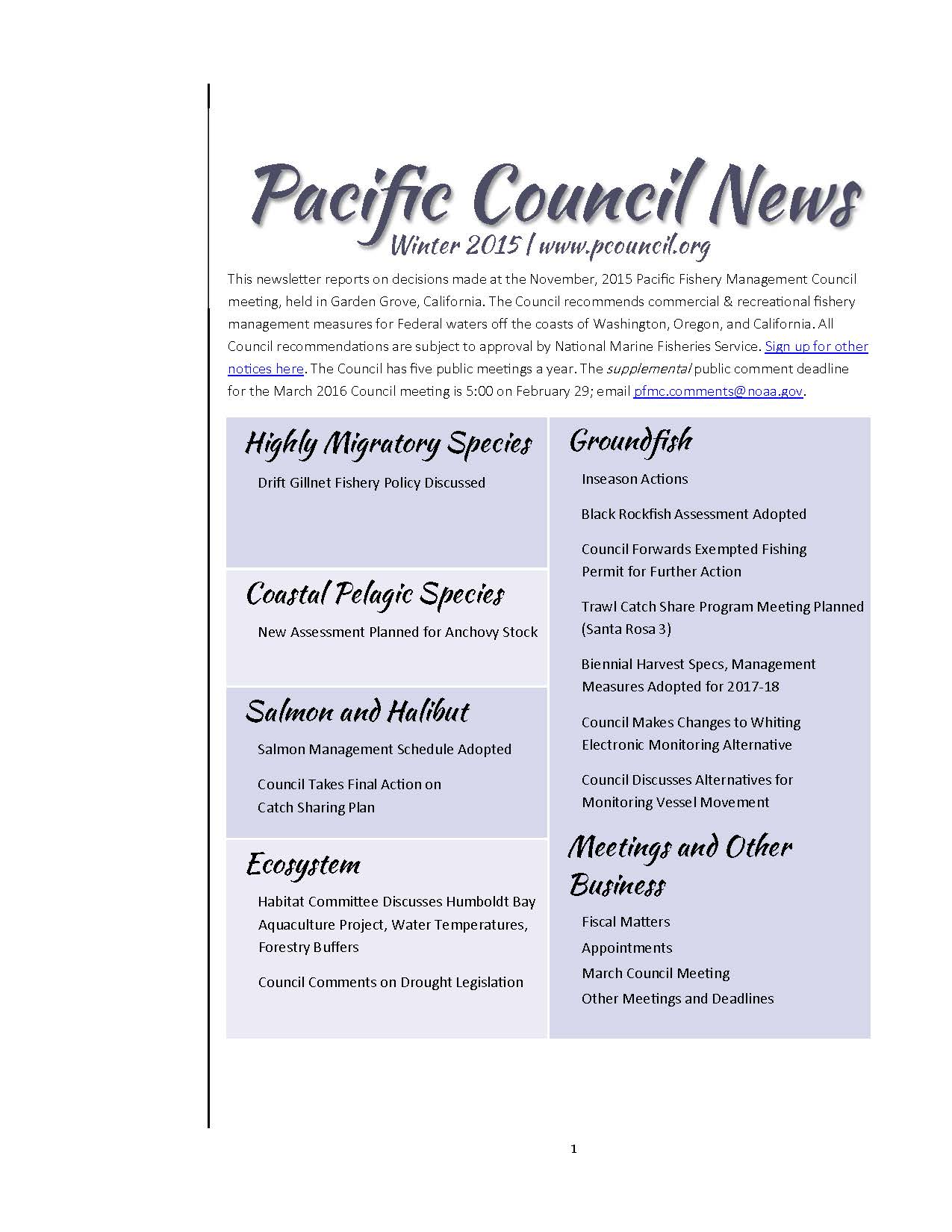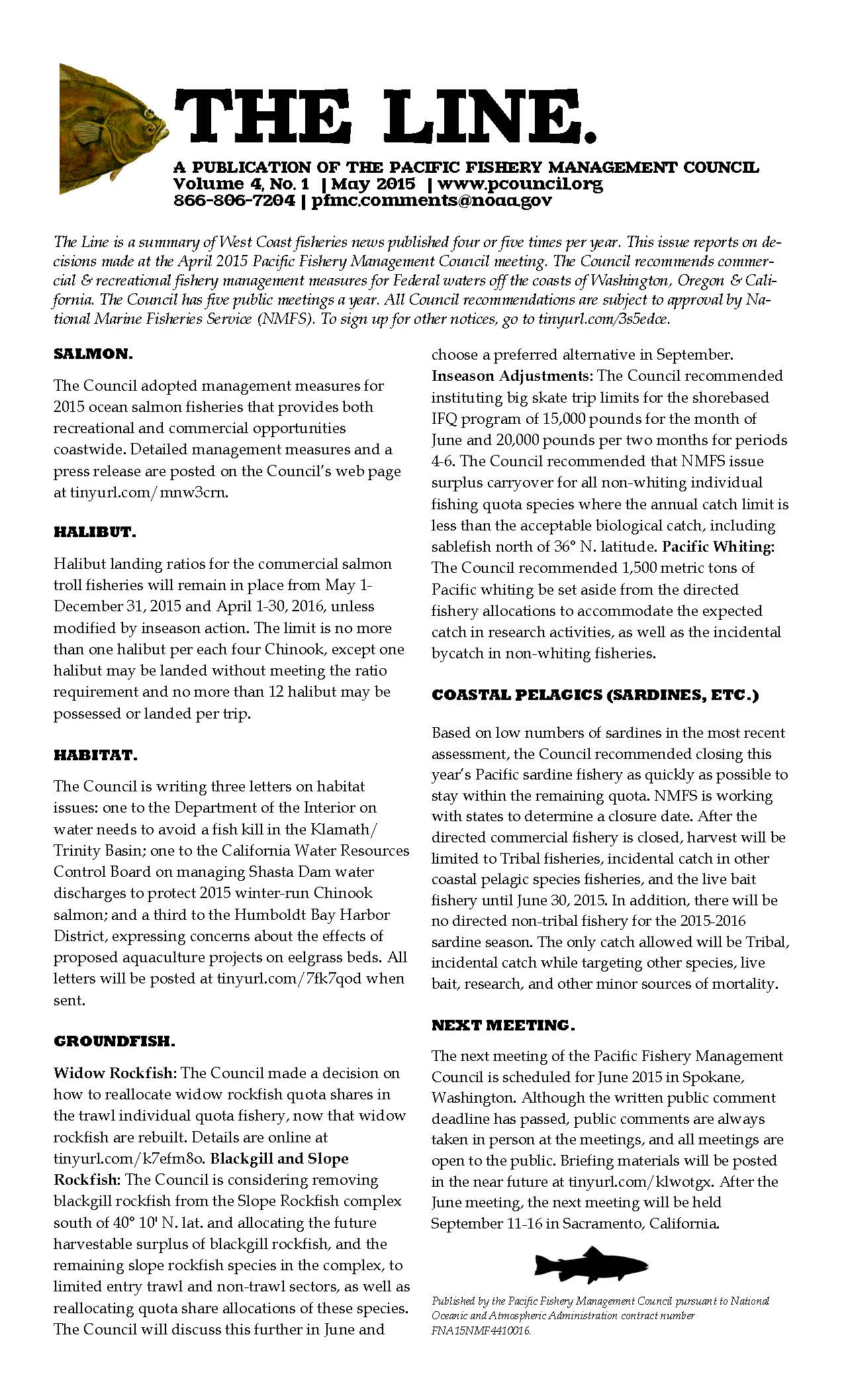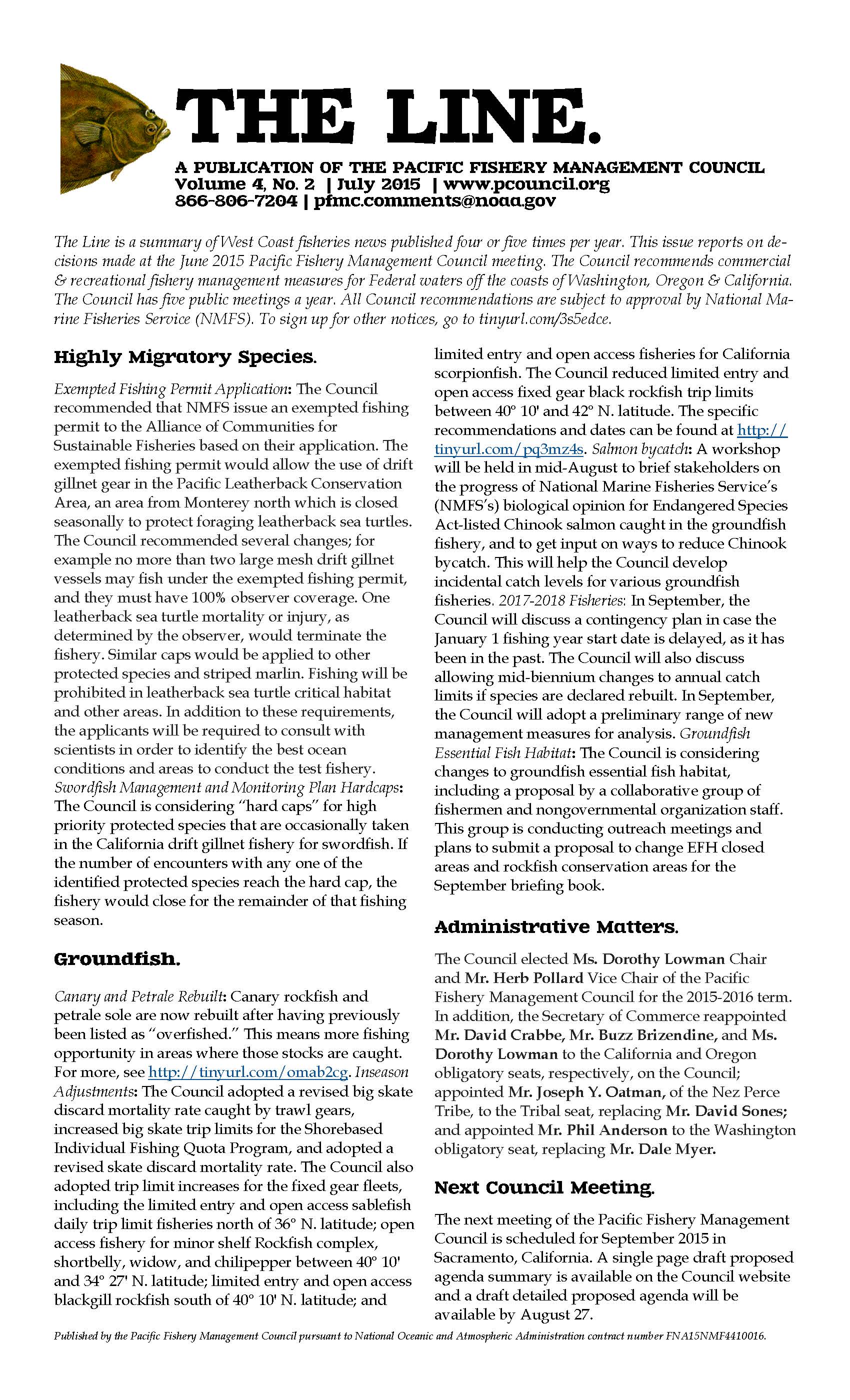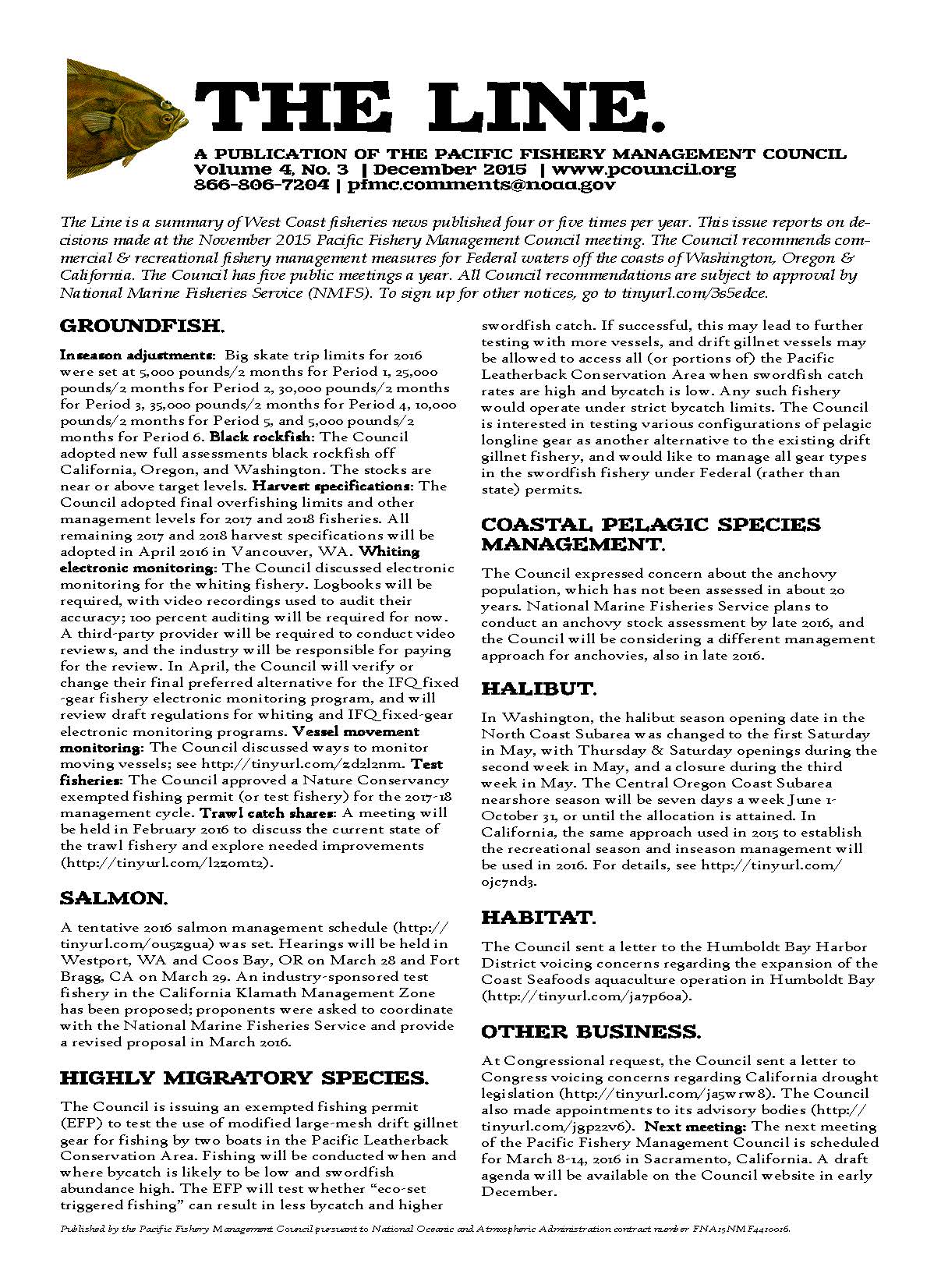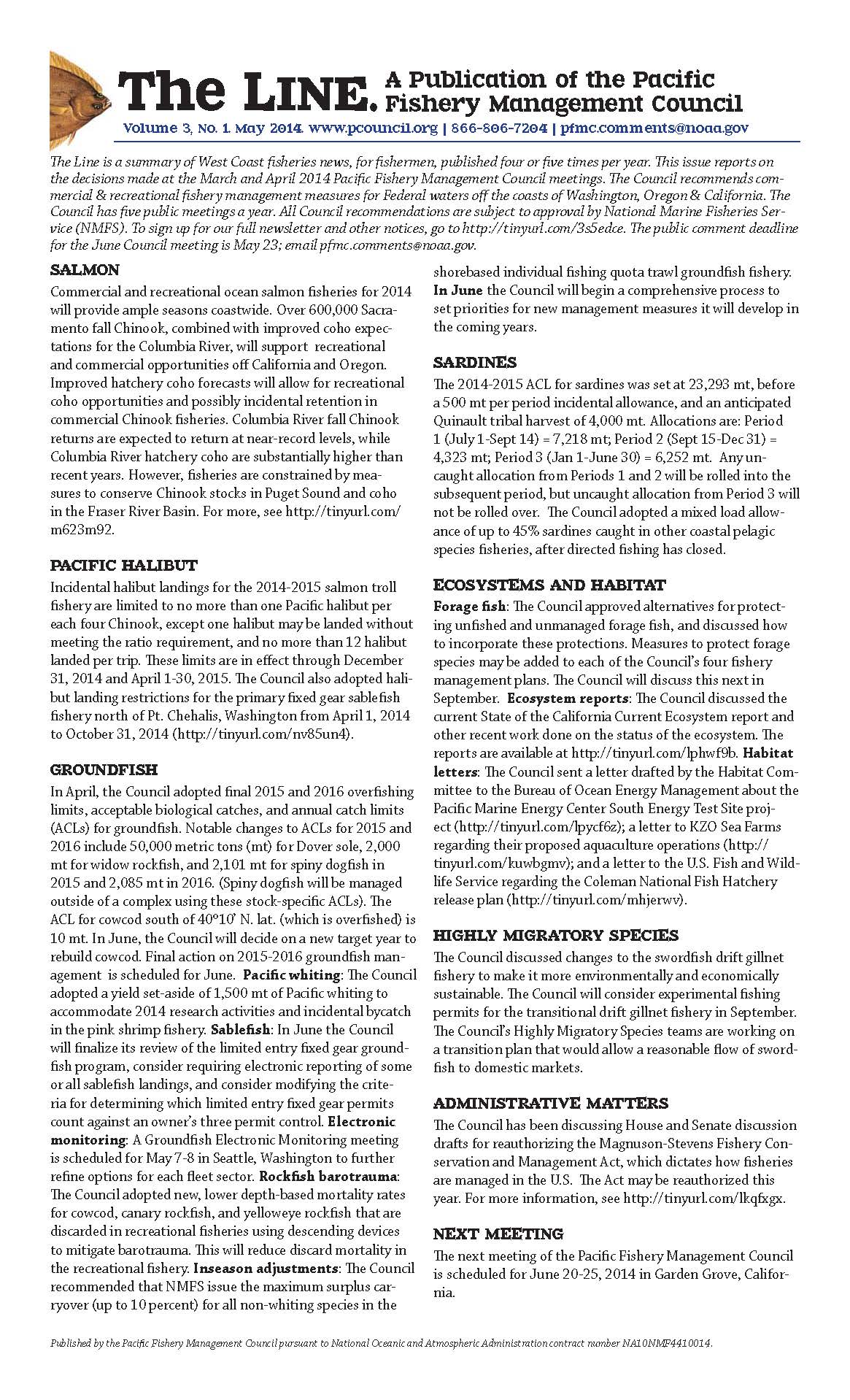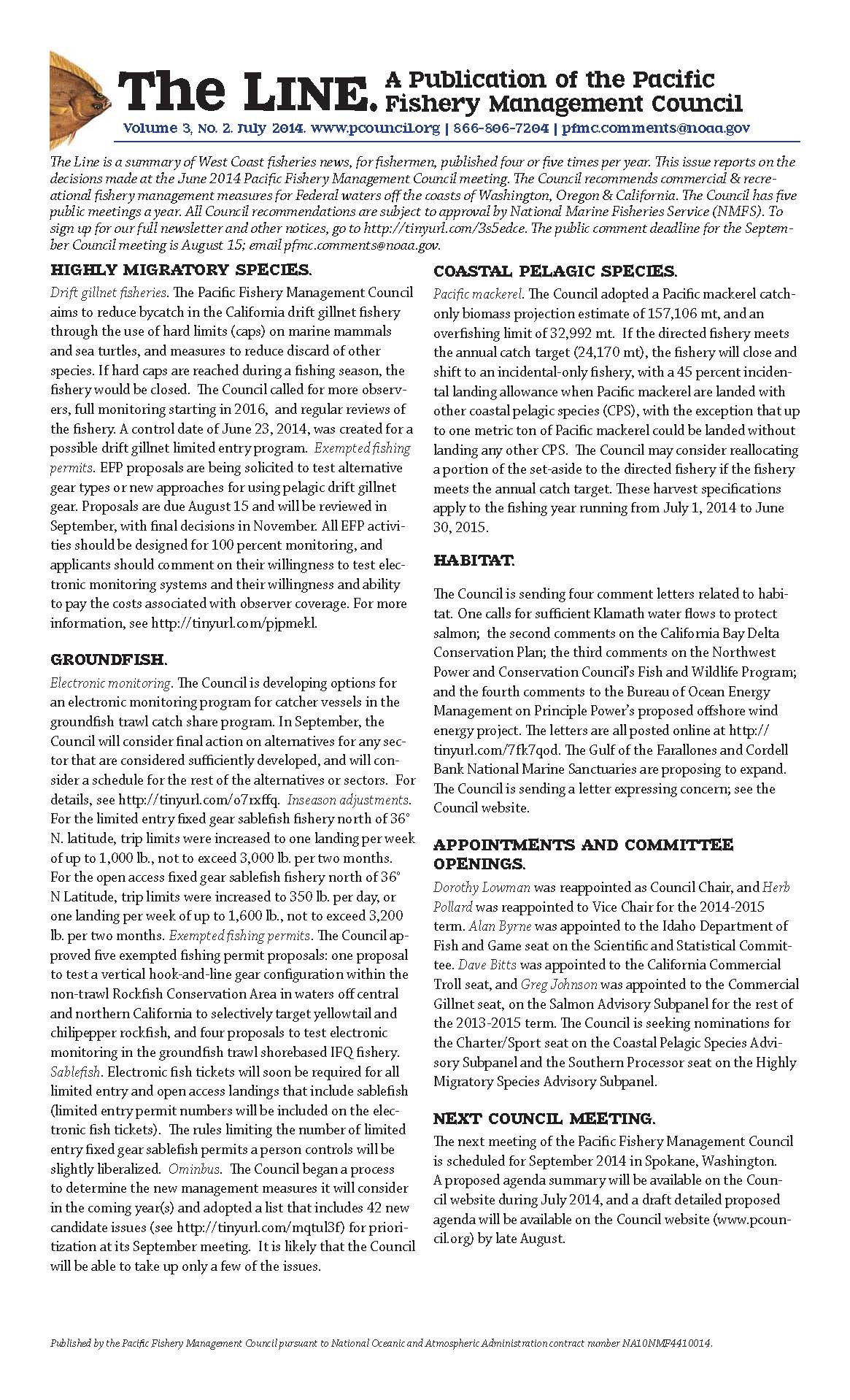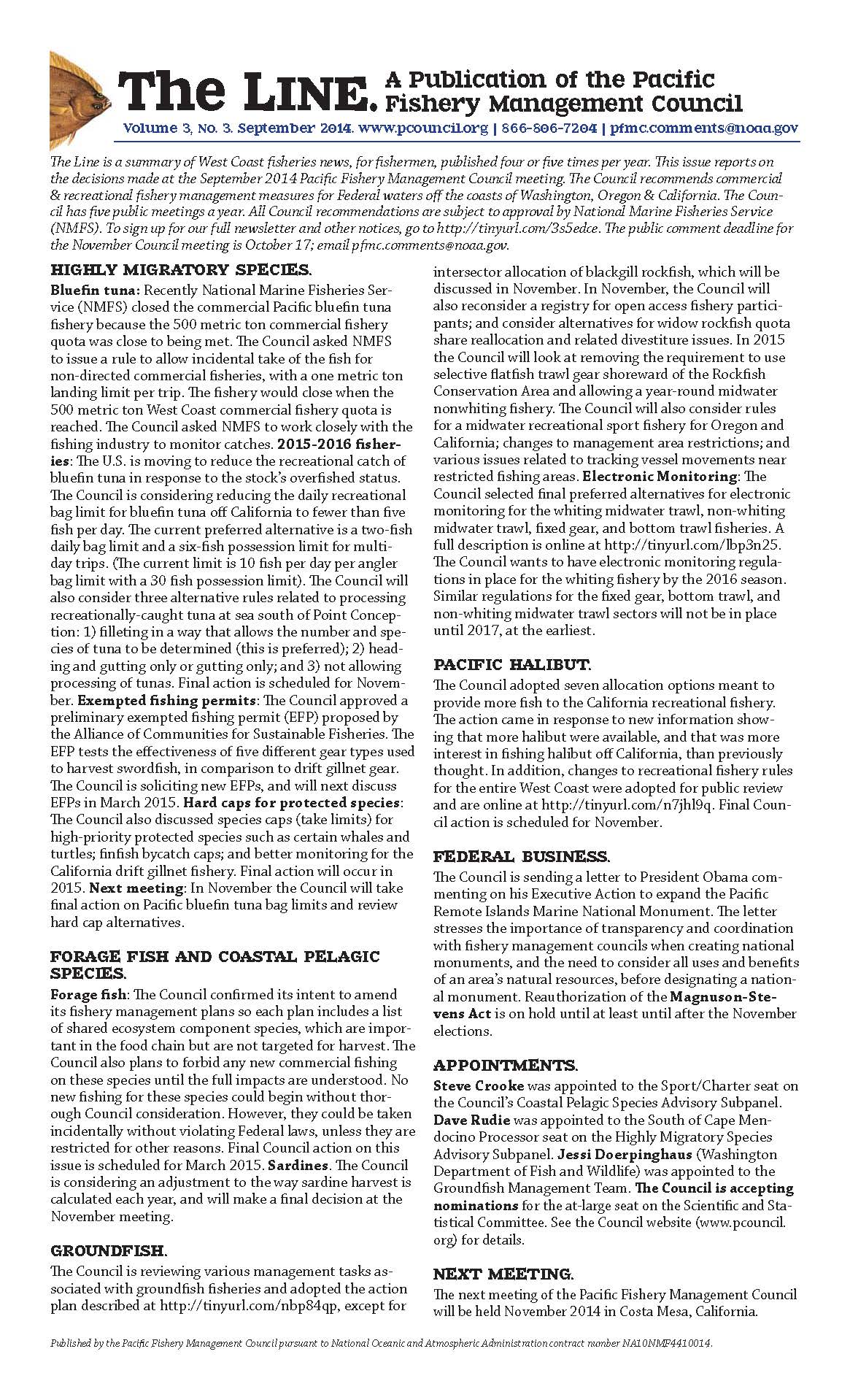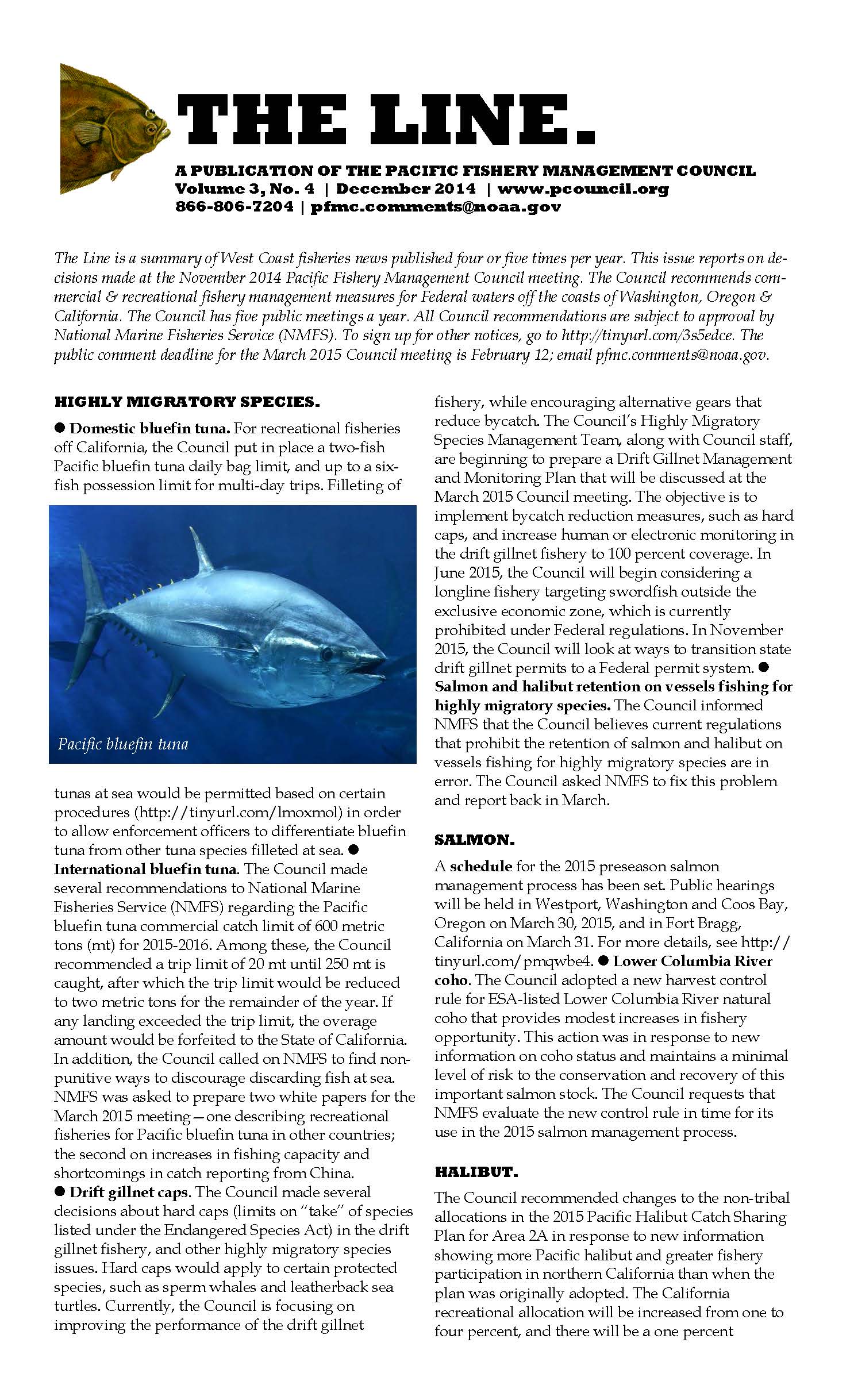Click image for full newsletter.
Updates
2017: Final preferred alternative for non-whiting midwater trawl and bottom trawl fisheries
The Groundfish Electronic Monitoring Policy Advisory Committee (GEMPAC) and Groundfish Electronic Monitoring Technical Advisory Committee (GEMTAC) met via webinar twice in early 2017 to discuss final recommendations for an electronic monitoring program for the non-whiting midwater trawl fishery for rockfish, as well as the bottom trawl fishery. The GEMPAC revised its preferred alternatives it selected in September 2014, and reported to the Council at its April meeting.
In April 2017, the Council received an exempted fishing permit update and reviewed draft regulations and reports from California Dept. of Fish and Wildlife and Council advisory bodies. At the meeting, the Council selected its preferred alternative and provided recommendations to National Marine Fisheries Service (NMFS) on implementing an electronic monitoring program for the non-whiting midwater trawl and bottom trawl fisheries.
In April the Council also asked NMFS to examine the feasibility of using Pacific States Marine Fisheries Commission (PSMFC) as a sole provider for the industry to conduct the video reviews and to develop new discard mortality rates for halibut when vessels use electronic monitoring. In September, NMFS determined that NMFS could not designate any service provider as a sole provider; however, PSMFC could compete for contracts as a third-party video provider for the industry or act on behalf of NMFS to audit or track compliance of third-party video review providers, but not both at the same time.
In November 2017, the Council adopted Pacific halibut discard mortality rates (DMRs) for the bottom trawl and non-whiting midwater trawl fisheries using electronic monitoring. The modeled mortality rates as described below were to be applied in 2018. All vessels were required to use best handling practices when discarding for the modeled rate to be applied, otherwise a default rate of 90 percent would be applied.
For the bottom trawl fishery:
- If an observer is not present to assess the viability of all halibut, implement a DMR rate for each halibut discarded under electronic monitoring using time on deck as described in the Groundfish Management Team model under Agenda Item F.11.a, GMT Report 1.
For the non-whiting midwater trawl fishery, the following will be applied:
- When a vessel declares optimized retention, a default rate of 90 percent will be applied to all halibut that are discarded.
- When a vessel declares maximized retention, the halibut must be landed and a DMR of 100 percent will be applied.
The Council also recommended that a species be added or removed from the allowable discard species list under an inseason action during one Council meeting and vessel monitoring plans be updated to reflect the change. A proposed rule to implement the electronic monitoring program elements for the bottom trawl and non-whiting midwater trawl fisheries was planned for summer, 2018.
Finally, the Council asked the Executive Director to explore opportunities to create a designated funding mechanism for electronic monitoring to help offset the cost of electronic monitoring, similar to that used by the North Pacific Fishery Management Council as authorized in Section 314 of the Magnuson-Stevens Act.
Cod or halibut with zucchini salsa verde
Ingredients
- 10 ounces zucchini (about 2 medium), trimmed, chopped
- 1/2 cup chopped fresh cilantro plus leaves for garnish
- 1/3 cup chopped white onion
- 5 tablespoons fresh lime juice
- 2 1/2 tablespoons chopped seeded jalapeño chiles
- 1 1/4 teaspoons finely grated lime peel
- 2 1/4 teaspoons coarse kosher salt, divided
- Nonstick vegetable oil spray
- 1 1/4 teaspoons freshly ground black pepper
- 1 1/4 teaspoons ground coriander
- 6 6-ounce skinless cod or halibut fillets
Directions
Combine zucchini, chopped cilantro, and next four ingredients in blender. Add 1 1/4 teaspoons coarse salt. Puree until salsa is smooth. Can be made two hours ahead. Transfer to small bowl. Cover; chill.
Preheat broiler. Line broiler pan with foil; coat foil with nonstick spray. Combine 1 1/4 teaspoons pepper, coriander, and remaining one teaspoon coarse salt in small bowl; stir to blend. Pat fish dry. Sprinkle fish on all sides with seasoning mixture.
Arrange fish on prepared pan. Broil until just opaque in center, three to four minutes per side, depending on thickness.
Transfer fish to plates. Spoon some salsa over. Garnish with cilantro leaves. Serve with remaining salsa.
Serves six. From Epicurious.com
Dover sole stuffed with crab and asparagus
Ingredients
- 4 dover sole fillets
- 8 fresh asparagus spears
- 1 cup Dungeness crab meat
- 1 cup heavy cream
- 1 tbsp fresh tarragon, finely chopped
- 1 shallot, chopped
- 1 tsp grated lemon peel
- salt and pepper
Directions
Trim stalk end of asparagus. Wash and drain well.
In a sauce pot, combine heavy cream, shallot and fresh tarragon. Bring to a boil and then lower heat. Simmer until sole fillets are ready and stuffed.
Season fillets lightly with salt and freshly-ground pepper. Place two asparagus and 1/4 cup of crab meat on one end of sole. Roll into a log to wrap the fillet over filling.
Arrange prepared sole on a baking dish with seam side down. Sprinkle grated lemon peel on top of sole. Pour cream and tarragon mixture over fish to coat entirely.
Bake uncovered in a 350º oven until just cooked through, around 10 to 15 minutes. Serve hot.
Baked fish and potatoes with rosemary and garlic
This recipe can be made with lingcod, Pacific cod, halibut, or any other firm white fish. An easy weeknight dish for four.
Ingredients
- 1 pound new potatoes, peeled (if desired), washed, and cut into wedges
- An oven-to-table baking dish that can accommodate both the fish and the potatoes in one layer
- 4 tablespoons extra virgin olive oil
- 4 or 5 fresh (not dried) rosemary sprigs
- 4 whole garlic cloves, peeled
- Fine sea salt
- Black pepper ground fresh from the mill
- A two-pound fillet (or fillets adding up to two pounds) from a firm-fleshed fish, such as Pacific cod, lingcod, or rockfish
- 2 tablespoons fine, dry, unflavored bread crumbs
Preparation
Preheat oven to 400°F.
Place the potato wedges in the baking dish, pour 2 tablespoons of the olive oil over them, add 2 sprigs of rosemary, all the garlic cloves, and salt, and pepper (may also mince garlic, if desired). Toss thoroughly. Put the dish in the preheated oven.
After 15 minutes, remove the dish to turn the potatoes over, then put it back in the oven. Cook until the potatoes feel tender when tested with a fork, another 10 minutes or so.
Remove the dish from the oven. Push the potatoes to the sides, making room in the center for the fish fillet to lie flat.
Wash the fish fillet, pat it dry with paper towels, and lay it flat in the dish, skin side down. Strip the leaves from the remaining rosemary sprigs, scatter them over the fish, add salt and pepper, and sprinkle the bread crumbs and the remaining 2 tablespoons olive oil over the fillet. Return the dish to the oven and bake for 14 minutes. Let the dish settle out of the oven for 3 to 4 minutes before bringing it to the table.
2016 newsletters
Click image for full newsletter.
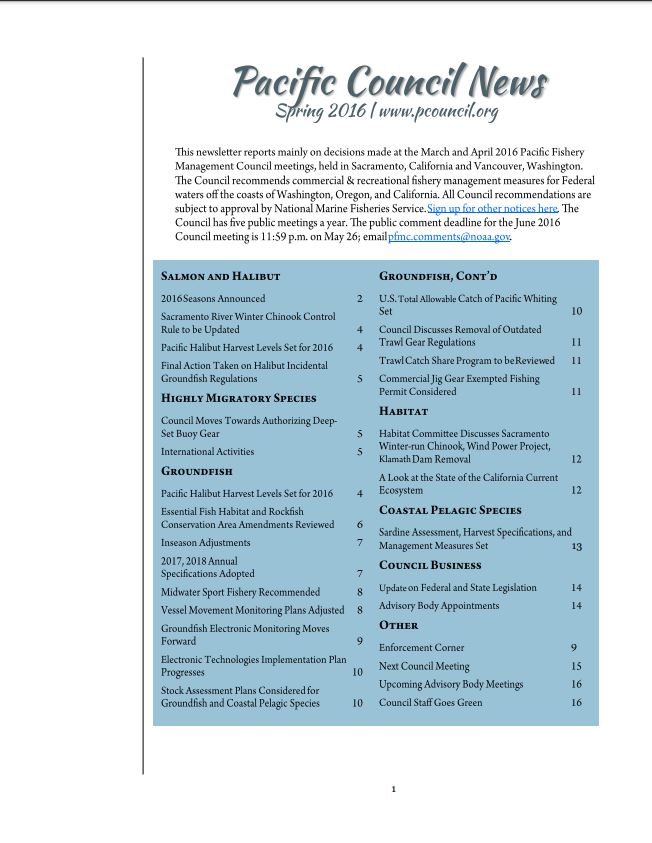
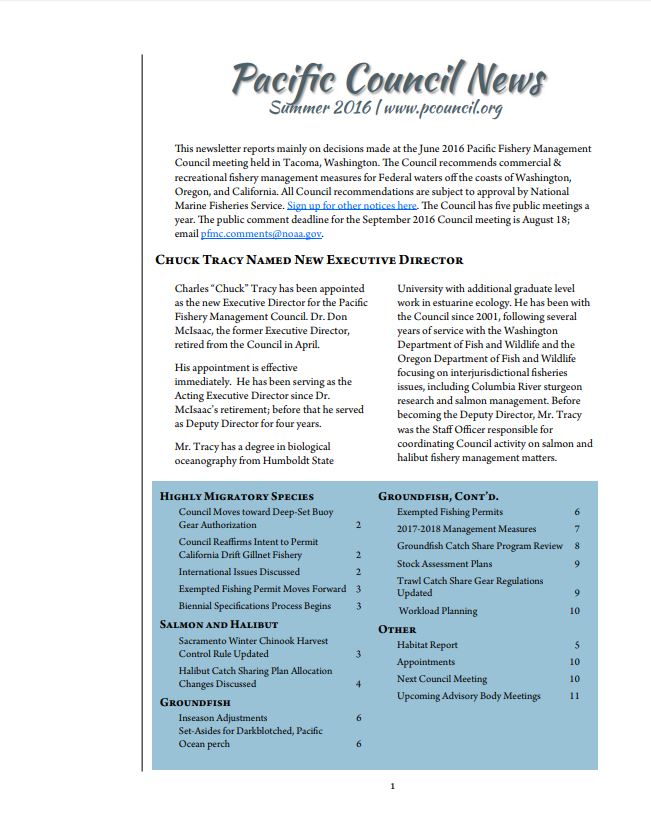
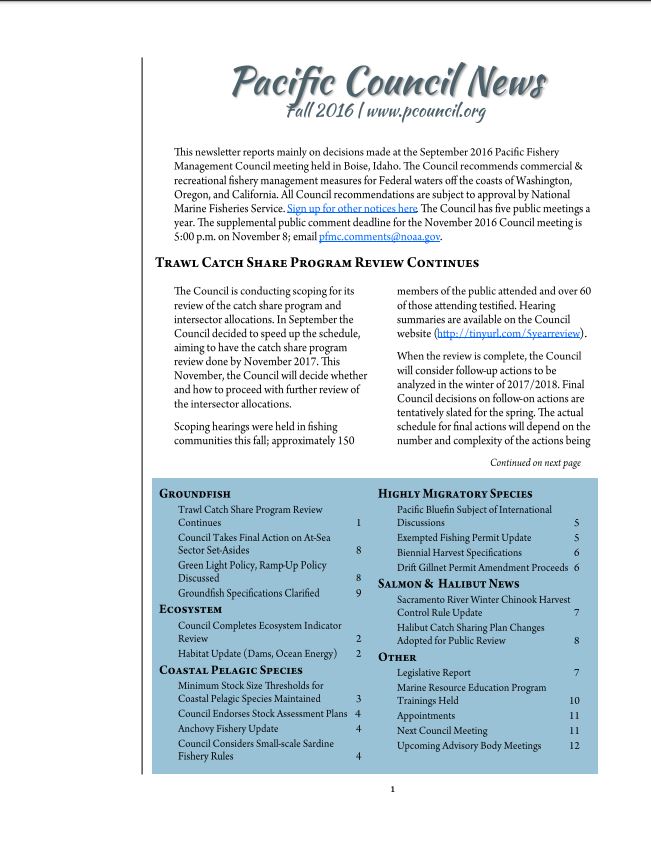
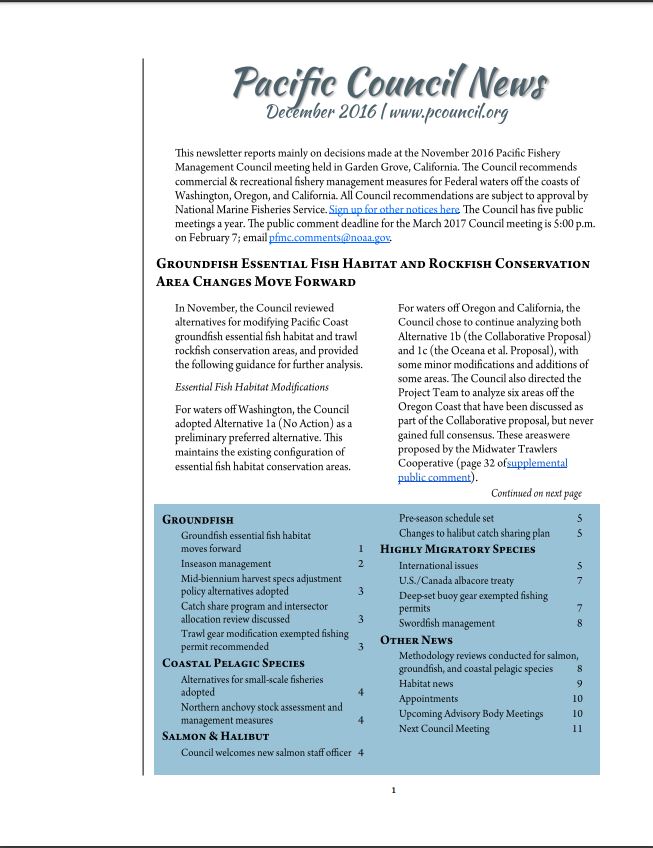
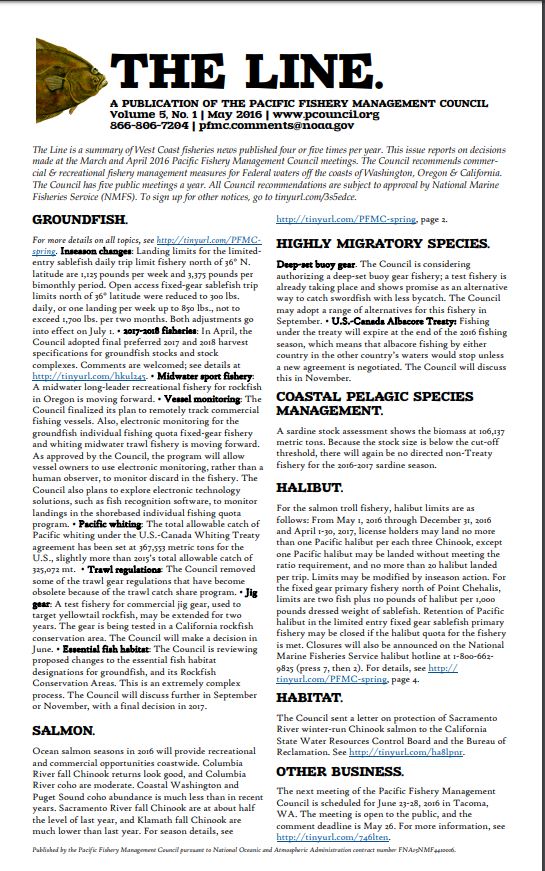
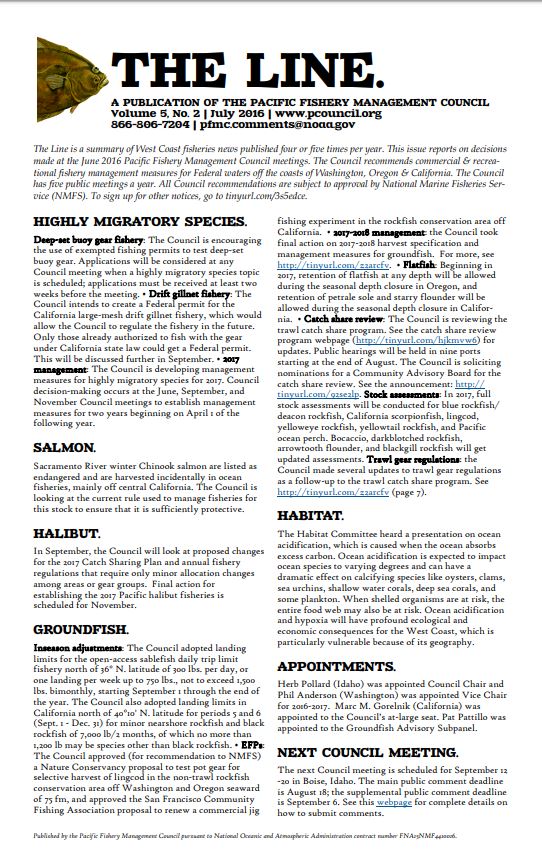
2016 Electronic monitoring actions
In March, the Council received an update on individual fishing quota fixed-gear and bottom trawl exempted fishing permit (EFP) activity.
The Council extended the expiration date of the electronic monitoring EFPs for the bottom trawl, non-whiting mid-water trawl, whiting mid-water trawl, and fixed gear catch share fisheries through 2018. The EFPs were to end when fleetwide regulations were put in place. This was expected for whiting midwater trawl fisheries and fixed gear fisheries in the spring of 2018.
In April, the Council modified their final preferred alternative for electronic monitoring for the fixed-gear fishery:
- Individual Vessel Monitoring Plan expiration was changed from 1 year to no expiration;
- Declaration of electronic monitoring use was changed from annual declaration to no limit on frequency – declaration stands until changed;
- Data Transfer Process removed shoreside monitor and retained only vessel operator and crew;
- Video and data processing was clarified that the Pacific States Marine Fisheries Commission should be eligible to be a 3rd-party video reviewer.
The Council also recommended the following changes based on Groundfish Electronic Monitoring Advisory Committee (GEMPAC) recommendations:
- Remove references to particular modes of communication (i.e., email).
- Discuss in the preamble of the proposed rule National Marine Fisheries Service (NMFS) standards for electronic monitoring providers to provide free litigation support to NMFS.
- Include a one-page electronic monitoring application process for existing electronic monitoring participants to reduce the paperwork burden for the industry.
- Include a general statement in the regulations that would require electronic monitoring providers to comply with state and Federal warranty statutes.
The Council recommended maintaining the proposed three-year record retention requirement but specified that it be reviewed before transitioning to third-party video reviewers, in order to reduce the time required for electronic monitoring providers to retain records.
Finally, the Council deemed the draft regulations as meeting the intent of the whiting final preferred alternative (see November 2015 Decision Summary for whiting electronic monitoring final preferred alternatives) and for the fixed gear fishery, with the expectation that NMFS would incorporate the final preferred alternatives and other Council recommendations. NMFS’s proposed rule for whiting and fixed gear fisheries was available on Oct 6, 2016.
2015 newsletters
2015: Council looks at electronic monitoring for whiting and fixed-gear IFQ fleets
The Council received a report, cost analysis, and draft regulations for an electronic monitoring program for the whiting midwater trawl fishery in November. The Council confirmed its final preferred alternatives for the whiting fishery at the same meeting. The Council’s intent was to have regulations applicable fleet-wide in place by the 2017 season (May 15, 2017 or earlier).
Also in November, the Council received an update on potential implementation of an electronic monitoring program for the IFQ fixed gear fleet along with the whiting fishery electronic monitoring program. The Council asked the GEMPAC and GEMTAC to review regulations for the whiting and fixed gear fisheries over the winter.
